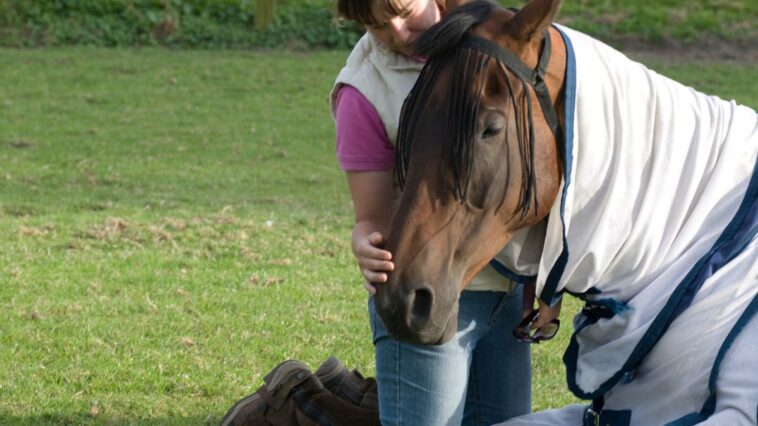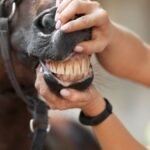Colic is a term used to describe abdominal pain in horses, and it is a common and often unpredictable condition that concerns horse owners.
The term encompasses a range of gastrointestinal disorders that can vary in severity and causes. Colic can be caused by various factors such as impactions, gas build-up, poor blood supply, or poor motility in the horse’s digestive system.
Horse owners need to be aware of colic symptoms and take preventive measures to minimize the risk of occurrence. This post will explore the causes, symptoms, treatment options, and preventive measures for colic in horses, providing valuable information for horse owners to understand and address this concerning condition.
What Is Colic In Horses?
Colic in horses refers to abdominal pain that can have various underlying causes. Colic can range from mild discomfort to a severe and life-threatening condition. It is a common and potentially serious condition that horse owners and caretakers must be aware of.
Colic is a general term for abdominal pain, but it’s crucial to note that it’s not a specific diagnosis. Rather, it’s a symptom of an underlying issue that needs to be identified.
The causes of colic can vary, including gastrointestinal disturbances, obstructions, gas accumulation, inflammation, torsion (twisting), or poor blood supply to the intestines.
Horses are particularly prone to colic due to their unique digestive system, adapted for grazing on forages. Their gastrointestinal tract is relatively long and complex, consisting of the esophagus, stomach, small intestine, cecum, large intestine (including the colon), and rectum. Any disruption or abnormality in the normal functioning of these organs can lead to colic.
Types of Colic in Horses
Horses have several types of colic, each with its underlying causes and characteristics. Here are some common types of colic:
Impaction Colic: This occurs when feed material, usually in the colon, forms a blockage that prevents normal passage. It can be caused by poorly chewed or dry feed, inadequate water intake leading to dehydration, poor motility, or a blockage in the digestive tract. Horses with impaction colic may be mildly painful and off-feed.
Gas Colic: Gas colic happens when excessive gas builds up in the horse’s gastrointestinal tract, causing enlargement and discomfort. It can be triggered by dietary changes or the consumption of highly fermented feeds. Most gas colics resolve with minimal treatment, but severe cases can lead to colon displacement.
Displacement or Torsion Colic: This type of colic occurs when a segment of the intestine moves out of its normal position. It can include colon shifts, where the long colon flips forward, hooks over a structure like a kidney, or twists like a phone cord. Displacement or torsion colic often causes severe or prolonged pain and may require emergency surgery to correct.
Enteritis/Colitis: Enteritis refers to inflammation of the small intestine, while colitis is inflammation of the large intestine. Horses with enteritis or colitis may exhibit colic signs, diarrhea, fever, and other systemic symptoms. Infections, parasites, or other factors can cause these conditions.
Strangulating Colic: Strangulating colic occurs when a portion of the intestine is twisted or obstructed, cutting off its blood supply. This severe and life-threatening form of colic requires immediate surgical intervention to relieve the twist or remove the obstruction.
Sand Colic: Sand colic results from ingesting sand or soil, accumulating in the intestine, and irritating the gut lining. It is more common in horses grazing on sandy pastures or eating hay off the ground. Symptoms may include weight loss, poor appetite, and colic-like signs. Treatment often involves the administration of laxatives to help remove the sand from the intestine.
Fecalith Colic: Fecaliths are hardened masses of feces that can obstruct the intestine. They can form due to dehydration, poor diet, or underlying gastrointestinal issues. Fecalith colic may require medical intervention or surgery to remove the obstruction.
These are just a few examples of the different types of colic that can affect horses. Each type has specific causes, diagnostic criteria, and treatment approaches. It is important to consult a veterinarian if your horse shows signs of colic to determine the underlying cause and appropriate course of action.
Symptoms of Colic in Horses
Recognizing colic symptoms in horses is essential for early detection and prompt veterinary intervention. Here are some common symptoms of colic in horses:
Abdominal Pain: Horses with colic often display signs of abdominal discomfort, which can vary in intensity. They may paw the ground, repeatedly lie down and get up, look at their sides, or kick at their abdomen. They may also exhibit restlessness, such as frequent weight shifting or rolling.
Loss of Appetite: Colicky horses typically show a reduced or complete loss of appetite. They may be uninterested in eating their usual feed or forage. Some horses may appear interested in food but quickly disappear and walk away.
Changes in Behavior: Horses in pain may exhibit changes in behavior. They might become more agitated, exhibit signs of anxiety or depression, or display unusual behaviors outside their normal character. They may also exhibit signs of discomfort when being touched or groomed.
Increased Heart Rate and Respiration: Colic can cause an increase in heart rate and respiration as the horse’s body responds to pain and stress. Monitoring these vital signs can provide important clues about the severity of the condition.
Pawing or Kicking at the Abdomen: Horses with colic may repeatedly paw at the ground with their front hooves or kick at their abdomen. This behavior is an attempt to alleviate the pain they are experiencing.
Rolling or Lying Down: Common signs of colic in horses include excessive rolling or repeatedly lying down and getting up. Horses may roll onto their backs or thrash around to alleviate the discomfort.
Absence or Decreased Passage of Feces: Colic can cause a decrease or cessation of normal bowel movements. Horses may have reduced manure production, pass small amounts of dry feces, or have difficulty passing feces.
Distended Abdomen: Some forms of colic can cause distension or bloating of the abdomen. The horse’s belly may appear swollen or larger than normal.
Sweating or Increased Body Temperature: Horses experiencing colic may sweat excessively, particularly in areas such as the neck, flank, or under the saddle. They may also exhibit an increased body temperature.
Lack of Gut Sounds: Listening to gut sounds using a stethoscope is a common method to assess gastrointestinal function. A decrease or absence of normal gut sounds can indicate an issue related to colic.
It is important to remember that colic symptoms can vary depending on the underlying cause and individual horse. If you suspect colic in your horse or notice any of these symptoms, it is crucial to contact a veterinarian immediately for proper diagnosis and treatment.
Causes of Colic in Horses
Colic in horses can have various causes, often a combination of factors contributing to its development. Here are some common causes of colic in horses:
Dietary Factors: Inadequate water intake, changes in diet or feeding routine, feeding large amounts of grain or concentrates, poor-quality forage, feeding moldy or spoiled feed, and abrupt changes in diet can all contribute to colic.
Parasites: Internal parasites, such as strongyles, can cause colic when they damage the intestinal lining or obstruct the intestines. Heavy parasite infestations can lead to colic episodes.
Impactions: Impactions occur when material, such as poorly chewed feed or coarse forage, forms a blockage in the gastrointestinal tract, most commonly in the colon. Insufficient water intake or dehydration can also contribute to impaction colic.
Gastrointestinal Disorders: Conditions like enteritis (inflammation of the small intestine) or colitis (inflammation of the large intestine) can cause colic. Infections, bacterial imbalances, or dietary issues can cause these conditions.
Gastric Ulcers: Ulcers in the stomach lining can cause discomfort and lead to colic symptoms. Factors contributing to gastric ulcer development include stress, prolonged fasting, high-grain diets, and inadequate forage consumption.
Intestinal Strangulation or Obstruction occurs when a portion of the intestine twists (volvulus) or becomes blocked by a physical obstruction, such as an ingested foreign object or a tumor. These cases often require emergency surgery to resolve.
Poor Dental Health: Dental problems, such as sharp points, loose or missing teeth, or malocclusion, can interfere with proper chewing and digestion of food, increasing the risk of colic.
Environmental Factors: Sudden changes in temperature, extreme weather conditions, exposure to toxins or poisonous plants, and stressful living conditions can all contribute to colic in horses.
Lack of Exercise or Poor Exercise Routine: Inadequate exercise or sudden intense exercise after inactivity can disrupt normal gastrointestinal motility and increase the risk of colic.
Individual Factors: Some horses may be more predisposed to colic due to their physiology or temperament. Certain breeds or age groups may have a higher susceptibility to colic.
It’s important to note that colic can be complex, and multiple factors are often involved. Prompt veterinary attention is crucial when a horse shows signs of colic to determine the underlying cause and initiate appropriate treatment.
Treatment Options for Colic in Horses
The treatment options for colic in horses depend on the underlying cause and severity of the condition. It is crucial to involve a veterinarian when colic is suspected to properly diagnose the specific type of colic and determine the appropriate treatment. Here are some common treatment options for colic in horses:
Veterinary Examination: A thorough examination by a veterinarian is essential to assess the horse’s vital signs, perform a physical examination, and potentially conduct diagnostic tests such as rectal palpation, abdominal ultrasound, or bloodwork to determine the cause of colic.
Pain Management: Medications may be administered to alleviate pain and discomfort. Non-steroidal anti-inflammatory drugs (NSAIDs) such as flunixin meglumine (Banamine) or meloxicam (Metacam) are commonly used to reduce pain and inflammation.
Fluid Therapy: Intravenous fluid therapy is often administered to prevent dehydration and restore fluid balance. Fluids may contain electrolytes to help correct any imbalances caused by colic.
Nasogastric Intubation: In impaction colic cases, a nasogastric tube may be passed through the horse’s nostril and into the stomach to relieve gas or administer fluids or medications. This procedure can help decompress the stomach and remove accumulated fluids or blockages.
Medical Management: Medical management for colic may involve using medications to promote gut motility, such as prokinetic agents like metoclopramide or cisapride. These medications can help stimulate the movement of the digestive tract and aid in the resolution of certain types of colic. The severity and cause of colic will determine the specific treatment approach.
Surgery: In severe cases, surgical intervention may be necessary when medical management fails or if there is a surgical condition. Common surgical procedures for colic include exploratory laparotomy, removal of intestinal obstructions, correction of twisted intestines, or resection of damaged intestines.
Supportive Care: Additional supportive care may include providing a quiet and stress-free environment for the horse, offering small and frequent meals of easily digestible feed, monitoring vital signs, and maintaining proper hygiene.
It is important to note that the specific treatment approach for colic will depend on the veterinarian’s assessment and the unique circumstances of each case. Early intervention and prompt veterinary care significantly improve the chances of successful treatment and recovery for horses with colic.
Preventing Colic in Horses
Preventing colic in horses involves implementing various management practices and making informed decisions regarding their care. While colic cannot be eliminated, the following measures can help reduce the risk:
- Consistent Feeding Routine: Establish a regular feeding schedule with consistent meal sizes and times. Avoid sudden changes in feed type or quantity, and introduce dietary changes gradually over several days.
- Adequate Water Supply: Ensure access to clean, fresh water. Monitor water sources for freezing in winter and provide warm water if necessary. Horses should be encouraged to drink frequently, especially during hot weather or when consuming dry forage.
- High-Quality Forage: Feed good-quality forage, such as hay or pasture, as the primary component of the horse’s diet. Avoid feeding moldy or dusty hay, as it can increase the risk of colic.
- Proper Feeding Practices: Feed hay from elevated feeders or racks to minimize the ingestion of sand, dirt, or debris. Avoid feeding directly on the ground in sandy areas to reduce the risk of sand colic.
- Regular Dental Care: Schedule regular dental examinations and floating of teeth to ensure proper chewing and digestion of food. Sharp points or dental abnormalities can interfere with the horse’s ability to chew effectively.
- Parasite Control: Develop and follow a veterinarian-recommended deworming program tailored to the horse’s needs. Regular deworming helps control internal parasites that can contribute to colic.
- Exercise and Turnout: Provide horses with regular exercise and ample turnout time. Exercise promotes gut motility and overall digestive health. Turnout allows for natural movement and grazing, which can help prevent digestive issues.
- Stress Management: Minimize stress and sudden changes in the horse’s environment, such as changes in stabling, herd dynamics, or training routines. Gradual transitions and a stable environment can help reduce the risk of colic.
- Monitor Pasture and Environment: Keep pastures clear of toxic plants and ensure the environment is free from hazards, such as sharp objects or debris that horses may ingest.
- Regular Veterinary Check-ups: Schedule routine veterinary check-ups to assess the horse’s overall health and address any potential issues before they become serious.
Remember, colic can still occur despite preventive measures, so it’s important to be vigilant and knowledgeable about the signs of colic. Promptly contact a veterinarian if colic symptoms are observed, as early intervention can greatly improve the horse’s prognosis.
Conclusion
Colic is a common and concerning condition in horses characterized by abdominal pain. While it cannot be completely prevented, horse owners can take various steps to minimize the risk of colic. Important preventive measures include proper nutrition, clean water, regular dental care, parasite control, exercise, and a stable environment.
Monitoring for signs of colic and seeking immediate veterinary care is crucial for early intervention and better outcomes. Owners can help reduce the occurrence and severity of colic episodes by being proactive and attentive to their horse’s well-being.




